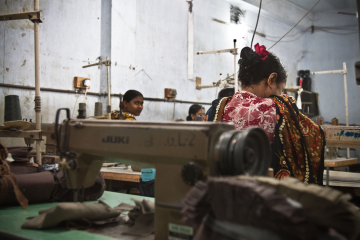We have attended many forums, conferences and seminars where participants are desperately asking why, after years of endless high-level rhetoric, there is no access to justice for victims of corporate abuse of human rights – a disgrace to society.
For various reasons, national courts are able to deal with only a small fraction of victims’ claims. Courts may be nonfunctional or inaccessible to victims. And even where a functional court is accessible it is not unusual for judgments to have only a limited effect.
While human rights litigation has been successful in publicly shaming corporate violators (while making some good legal precedents in selected cases), it has compensated only a handful of victims. It has been noted that plaintiffs as well as defendants can face serious problems when dealing with a local judiciary. A court judgment in a host country might, for example, be politically influenced or swayed by corruption.
With this in mind, we believe that international arbitration could be an avenue facilitating access to justice for victims of corporate human rights abuse.
Arbitration has been used as a peaceful means to conclude a variety of disputes throughout history. For example, Homer’s Iliad describes the use of arbitration as a public means to resolve disputes. The earliest law dedicated to arbitration in England was in 1697 and in France the Constitution of 1791. President Washington stated that he considered any arbitration decisions stemming from his will to be as final and binding as any decision of the Supreme Court of the United States. Labour unions developed the use of grievance arbitration (e.g. the United Mine Workers of America in 1890). The Permanent Court of Arbitration was founded 1899 in The Hague to help governments arbitrate disputes, rather than go to war. As world trade expanded and disputes became increasingly complex, arbitration flourished. For example, arbitral institutions were founded in, among other cities, London, Stockholm, Paris, New York, Beijing, Hong Kong and Singapore.
Arbitration does not replace or substitute national courts. It should be seen as complementary to our present judiciary.
We are proposing that a team of experts in international law that represents diverse stakeholders should draft a set of business and human rights arbitration and conciliation rules specifically designed to meet the particular needs of disputants in business and human rights matters. These procedural rules, and the application thereof, provisionally called “the Tribunal,” would be administered by a highly skilled arbitral institution. The Tribunal would provide the following key features:
-
The disputants would be able to tailor arbitration proceedings to their needs, independent of State processes.
-
Instead of court proceedings that often take five to ten years, the Tribunal could significantly shorten the time for resolving a dispute, initially through mediation or, if unsuccessful, by obtaining a final arbitration award.
-
Hearings could take place at times and in places that meet the needs of the parties, thus providing justice virtually anywhere in the world, which would be particularly important for disputants where courts are not accessible.
-
Instead of having to submit to judges chosen by “the luck of the draw” in national courts, the parties could choose arbitrators who have high levels of expertise directly related to the issues in dispute.
-
Instead of being dependent on existing complex and frail mechanisms for enforcing final awards, awards could be enforceable throughout the world under the New York Arbitration Convention (the New York Convention on the Enforcement of Foreign Arbitral Awards was adopted 1958 and has152 signatory states – a very successful system in obtaining the recognition and enforcement of international awards and is a cornerstone of international arbitration).
-
In contrast to some investor-State arbitrations, proceedings and awards would be publicly accessible.
The Tribunal could be used to enforce clauses in supply chain contracts that require any dispute arising over a breach of a commitment to observe international human rights norms to be referred to mediation and/or arbitration. Referencing the Tribunal in such a clause would provide a healthy incentive for a supplier to live up to its commitments and, should an actual dispute arise, resolve the situation through a recognized conciliation and arbitration process.
Lenders, governmental agencies and others could make use of the Tribunal as a way to carry forward their own responsibilities for ensuring that multinational business enterprises and their suppliers comply with international human rights norms. For example, a lender could insist that its borrowers insert arbitration clauses into their supply chain contracts and even allow victims to initiate or join the proceedings. Or public agencies that have human rights responsibilities could insist that multinational business enterprises utilize such an approach, either as a condition of their doing business within the agencies’ jurisdictions or in return for any governmental authorization or assistance.
In these ways, the Tribunal shows promise of becoming an avenue for business enterprises to implement their responsibilities under the UN “Protect, Respect, and Remedy” Framework for business and human rights. The second (“Respect”) pillar requires them to conduct due diligence on their potential human rights impacts and to “prevent,” “mitigate” and “remediate” any impacts that are identified, whether as a result of their own activities or those of their business partners, such as suppliers. The Tribunal could also help implement the UN Framework’s third (“Remedy”) pillar by providing expert mediation/conciliation as a non-judicial grievance mechanism. It would offer speed, reduced costs and, if relevant, transnational reach. If mediation fails, entirely or partly, the disputants could move to arbitration.
Thus far the Tribunal proposal has met with positive responses from a number of human rights NGOs as well as a number of multinational corporations. NGOs argue that the Tribunal should be tailored to the specific needs of victims of business-related human rights abuses. The business responses indicate a favourable view of arbitration as a potential fast lane for dispute resolution and a way to level the corporate playing field by reducing the use of human rights abuses as a form of unfair competition. The Tribunal proposal shows great promise of meeting all of these needs.





























How should businesses respond to an age of conflict and uncertainty?
As 2024 began, European Commission President Ursula von der Leyen aptly summed up our deeply worrying collective moment. As she put it, speaking at the annual World Economic Forum in Switzerland, we are moving through “an era of conflict and...
26 March 2024 | Commentary
Commentary by Scott Jerbi, Senior Advisor, Policy & Outreach, IHRB